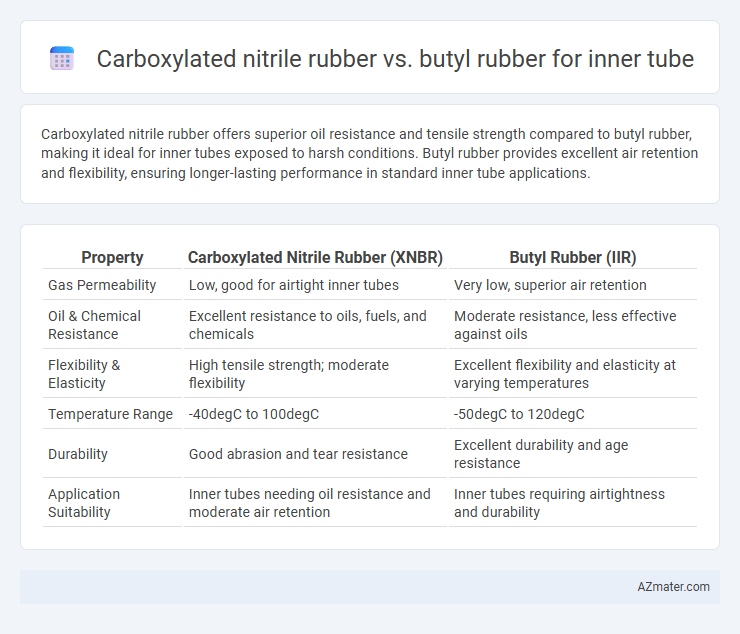Carboxylated nitrile rubber offers superior oil resistance and tensile strength compared to butyl rubber, making it ideal for inner tubes exposed to harsh conditions. Butyl rubber provides excellent air retention and flexibility, ensuring longer-lasting performance in standard inner tube applications.
Table of Comparison
| Property | Carboxylated Nitrile Rubber (XNBR) | Butyl Rubber (IIR) |
|---|---|---|
| Gas Permeability | Low, good for airtight inner tubes | Very low, superior air retention |
| Oil & Chemical Resistance | Excellent resistance to oils, fuels, and chemicals | Moderate resistance, less effective against oils |
| Flexibility & Elasticity | High tensile strength; moderate flexibility | Excellent flexibility and elasticity at varying temperatures |
| Temperature Range | -40degC to 100degC | -50degC to 120degC |
| Durability | Good abrasion and tear resistance | Excellent durability and age resistance |
| Application Suitability | Inner tubes needing oil resistance and moderate air retention | Inner tubes requiring airtightness and durability |
Introduction to Inner Tube Materials
Carboxylated nitrile rubber (XNBR) offers enhanced abrasion resistance, tensile strength, and low permeability to gases, making it suitable for inner tubes in performance applications where durability and air retention are critical. Butyl rubber excels in airtight properties and chemical resistance, commonly used for inner tubes due to its excellent impermeability to air and superior flexibility at varying temperatures. The choice between XNBR and butyl rubber depends on specific requirements for gas retention, mechanical strength, and environmental resilience in tire inner tube manufacturing.
Overview of Carboxylated Nitrile Rubber
Carboxylated nitrile rubber (XNBR) offers enhanced abrasion resistance, tensile strength, and oil resistance compared to traditional nitrile rubber due to the presence of carboxyl groups that improve cross-linking density. This material exhibits excellent low-temperature flexibility and superior impermeability, making it highly suitable for inner tube applications where durability and airtight performance are critical. Its chemical resistance against fuels and lubricants surpasses butyl rubber, while maintaining comparable elasticity and heat resistance, positioning XNBR as a premium choice for high-performance inner tubes.
Key Properties of Butyl Rubber
Butyl rubber exhibits exceptional air impermeability, chemical resistance, and good flexibility, making it ideal for inner tube applications where airtightness and durability are essential. Compared to carboxylated nitrile rubber, butyl rubber offers superior resistance to oxidation, ozone, and aging, extending the lifespan of inner tubes in harsh conditions. Its low gas permeability combined with excellent thermal stability enhances overall performance and reliability in automotive and bicycle inner tubes.
Air Retention Capabilities Compared
Carboxylated nitrile rubber (XNBR) exhibits superior air retention capabilities compared to butyl rubber, owing to its enhanced gas impermeability and resistance to air leakage. XNBR's molecular structure allows for tighter polymer chains, significantly reducing the permeability of nitrogen and oxygen, which are primary gases in inner tubes. While butyl rubber also offers excellent air retention due to its low gas permeability, XNBR's balance of flexibility and chemical resistance provides a more durable and reliable seal under varied temperature and pressure conditions.
Resistance to Weather and Ozone
Carboxylated nitrile rubber (XNBR) exhibits superior resistance to ozone and weathering compared to butyl rubber, making it more durable in harsh outdoor conditions. XNBR's enhanced polarity improves its resistance to degradation caused by UV radiation and oxidative elements. Meanwhile, butyl rubber offers excellent impermeability but generally shows less resistance to ozone-induced cracking over prolonged exposure.
Flexibility and Elasticity Differences
Carboxylated nitrile rubber (XNBR) offers superior elasticity and enhanced flexibility compared to butyl rubber, making it ideal for inner tubes that require rapid recovery and durability under dynamic stress. Butyl rubber excels in air retention and chemical resistance but generally provides less flexibility and elasticity, resulting in a stiffer inner tube performance. The molecular structure of XNBR with carboxyl groups improves intermolecular bonding, directly contributing to its increased stretchability and resilience over butyl formulations.
Chemical and Oil Resistance Performance
Carboxylated nitrile rubber (XNBR) exhibits superior chemical and oil resistance compared to butyl rubber, making it ideal for inner tubes exposed to harsh environments. XNBR's enhanced polarity due to carboxyl groups improves its compatibility with polar solvents and oils, resulting in reduced swelling and degradation. Butyl rubber offers excellent air impermeability but falls short in resistance to petroleum-based oils and chemicals, limiting its use in applications requiring high chemical resilience.
Durability and Longevity in Use
Carboxylated nitrile rubber (XNBR) exhibits superior abrasion resistance and chemical stability, enhancing the durability of inner tubes exposed to harsh conditions like oils and fuels. Butyl rubber offers excellent air retention and elasticity, providing extended longevity by minimizing air leakage over time. While XNBR excels in wear resistance, butyl rubber remains the preferred choice for inner tubes requiring optimal airtightness and sustained performance under varied pressure cycles.
Cost-Effectiveness and Availability
Carboxylated nitrile rubber offers enhanced durability and resistance to oils and abrasion, making it cost-effective for high-performance inner tubes, despite a slightly higher material cost. Butyl rubber remains more widely available and less expensive, providing adequate air retention and flexibility for standard inner tube applications. The choice depends on balancing the demand for durability and resistance against overall budget and supply chain considerations.
Conclusion: Best Choice for Inner Tubes
Carboxylated nitrile rubber offers superior oil resistance, abrasion durability, and flexibility, making it ideal for high-performance inner tubes exposed to harsh conditions. Butyl rubber excels in air retention and chemical inertness, providing longer inflation stability and excellent resilience against environmental factors. For inner tubes, the best choice depends on the application requirements: carboxylated nitrile rubber suits demanding, rugged use, while butyl rubber is preferred for reliable air retention and general-purpose durability.

Infographic: Carboxylated nitrile rubber vs Butyl rubber for Inner tube
 azmater.com
azmater.com